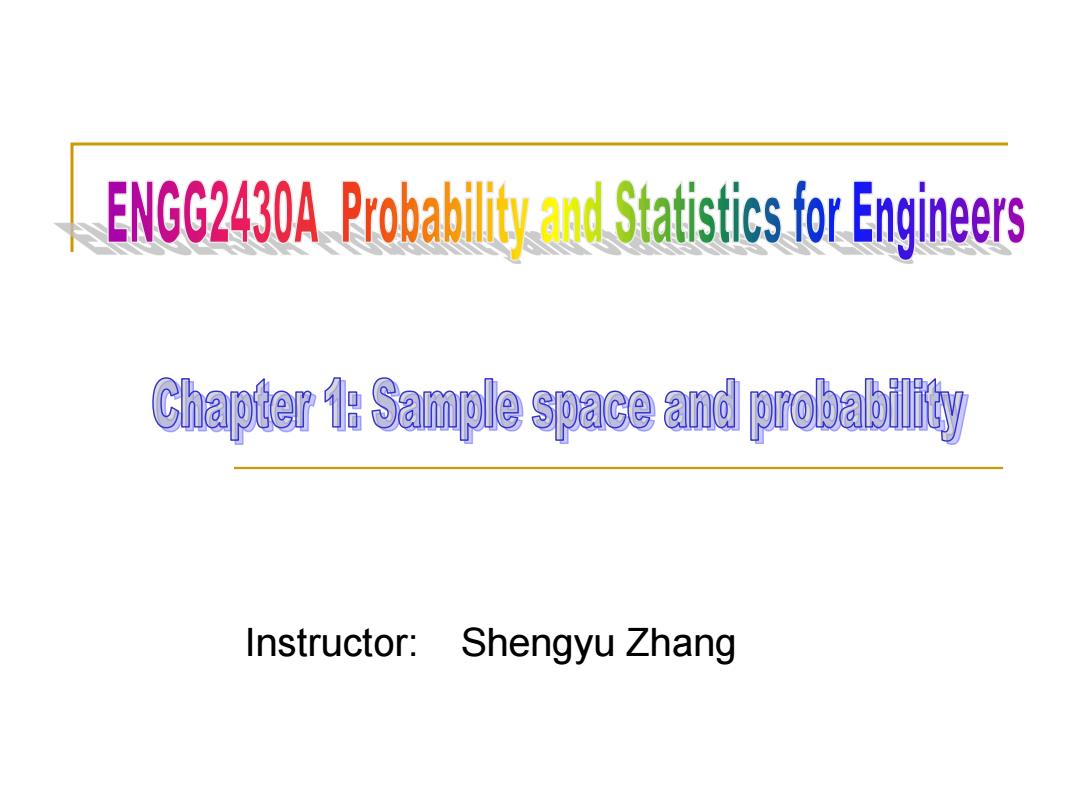
ENGG40Protatisics for Chapter 1:Sample space and probability Instructor:Shengyu Zhang
Instructor: Shengyu Zhang

About the course ■Vebsite: http://www.cse.cuhk.edu.hk/~syzhang/course /Prob17/ You can find the lecture slides,tutorial slides, info for time,venue,TA,textbook,grading method,etc. No tutorial in the first week. Announcements will be posted on web. The important ones will be sent to your cuhk email as well
About the course Website: http://www.cse.cuhk.edu.hk/~syzhang/course /Prob17/ You can find the lecture slides, tutorial slides, info for time, venue, TA, textbook, grading method, etc. No tutorial in the first week. Announcements will be posted on web. The important ones will be sent to your cuhk email as well
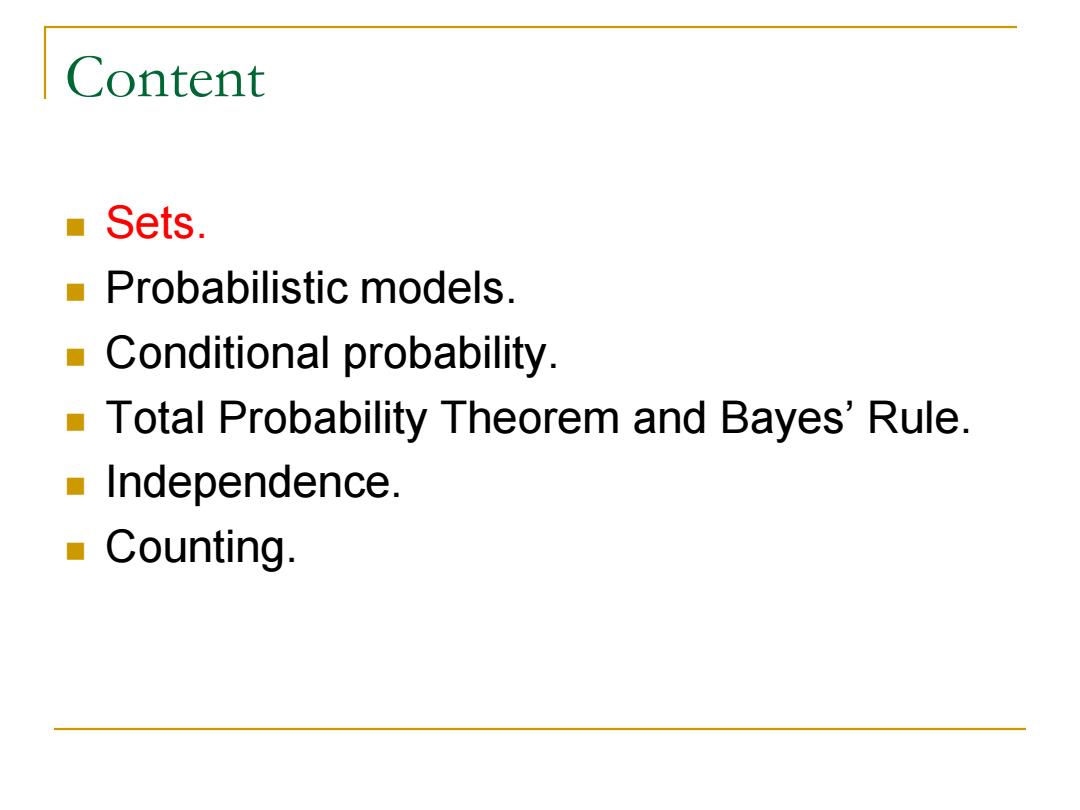
Content Sets. Probabilistic models. ■ Conditional probability. Total Probability Theorem and Bayes'Rule. Independence. Counting
Content Sets. Probabilistic models. Conditional probability. Total Probability Theorem and Bayes’ Rule. Independence. Counting

Sets Probability makes extensive use of set operations. A set is a collection of objects,which are the elements of the set. ■x∈S:S is a set and x is an element of S xS:x is not an element of S. ■ 0:A set that has no elements;called empty set
Sets Probability makes extensive use of set operations. A set is a collection of objects, which are the elements of the set. 𝑥 ∈ 𝑆: 𝑆 is a set and 𝑥 is an element of 𝑆 𝑥 ∉ 𝑆: 𝑥 is not an element of 𝑆. ∅: A set that has no elements; called empty set
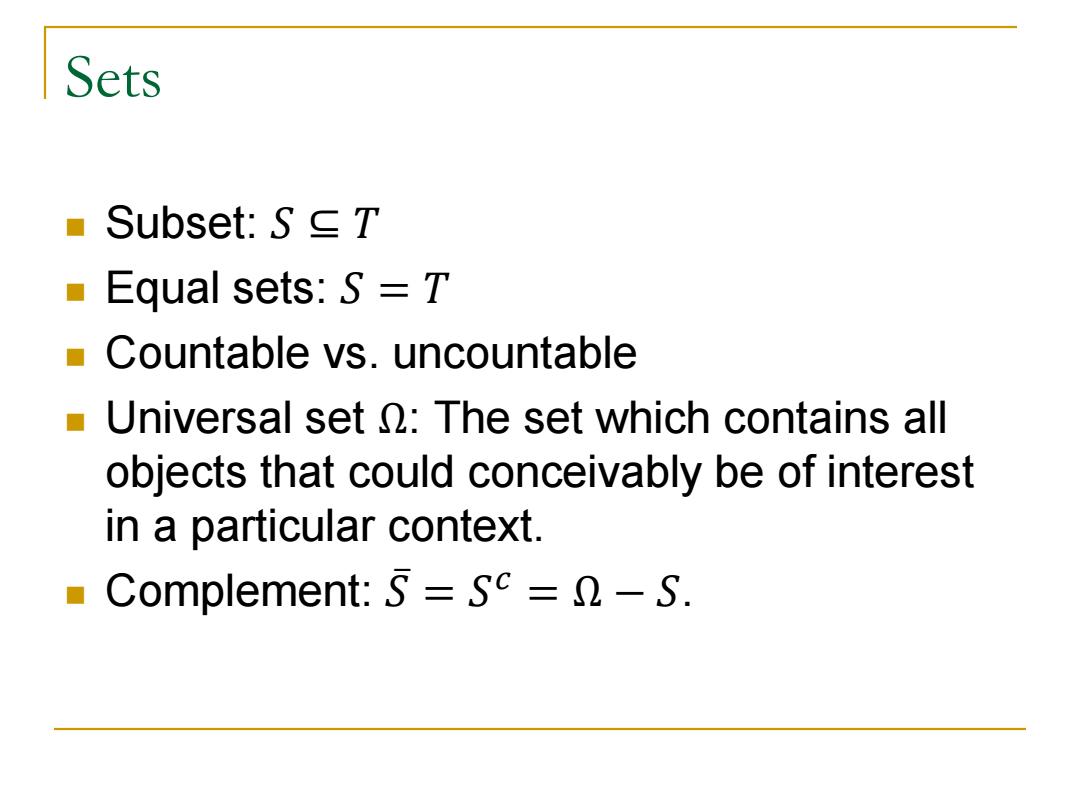
Sets ■Subset:ScT Equal sets:S=T Countable vs.uncountable Universal set 0:The set which contains all objects that could conceivably be of interest in a particular context Complement:S=Sc=-S
Sets Subset: 𝑆 ⊆ 𝑇 Equal sets: 𝑆 = 𝑇 Countable vs. uncountable Universal set Ω: The set which contains all objects that could conceivably be of interest in a particular context. Complement: 𝑆 = 𝑆 𝑐 = Ω − 𝑆

Sets Union of sets:S UT,USi,UieI Si. Intersection of sets:SnT,nSi,Nier Si. Disjoint sets:empty pairwise intersection. Partition of set S:a collection of disjoint sets whose union is S. De Morgan's laws: U:Si=n;Si,∩S=US
Sets Union of sets: 𝑆 ∪ 𝑇, 𝑆𝑖 ∞ 𝑖=1 , 𝑖∈𝐼 𝑆𝑖 . Intersection of sets: 𝑆 ∩ 𝑇, 𝑆𝑖 ∞ 𝑖=1 , 𝑖∈𝐼 𝑆𝑖 . Disjoint sets: empty pairwise intersection. Partition of set 𝑆: a collection of disjoint sets whose union is 𝑆. De Morgan’s laws: 𝑖 𝑆𝑖 = 𝑆𝑖 𝑖 , 𝑖 𝑆𝑖 = 𝑆𝑖 𝑖
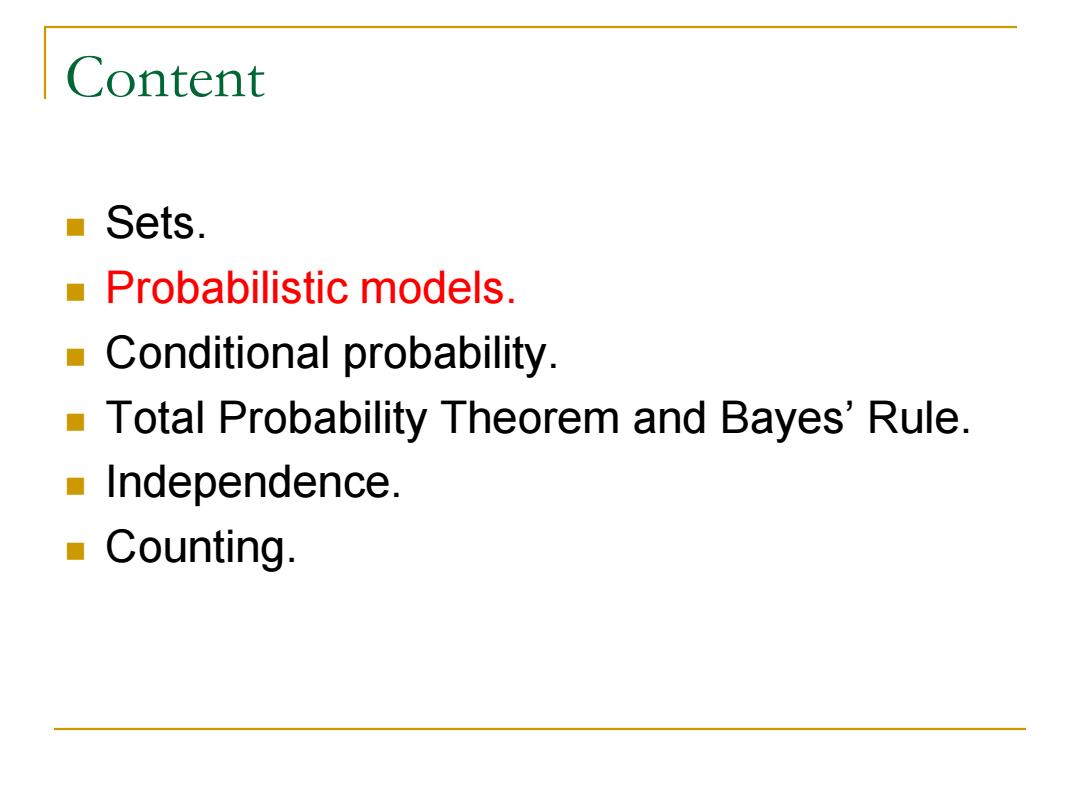
Content Sets. Probabilistic models. ■( Conditional probability. Total Probability Theorem and Bayes'Rule. Independence. Counting
Content Sets. Probabilistic models. Conditional probability. Total Probability Theorem and Bayes’ Rule. Independence. Counting

Experiment and outcomes A probabilistic model is a mathematical description of an uncertain situation. Every probabilistic model involves an underlying process,called the experiment Example.Flip two coins. The experiment produces exactly one out of several possible outcomes. Example.four outcomes:(HH,HT,TH,TT
Experiment and outcomes A probabilistic model is a mathematical description of an uncertain situation. Every probabilistic model involves an underlying process, called the experiment. Example. Flip two coins. The experiment produces exactly one out of several possible outcomes. Example. four outcomes: 𝐻𝐻, 𝐻𝑇, 𝑇𝐻, 𝑇𝑇
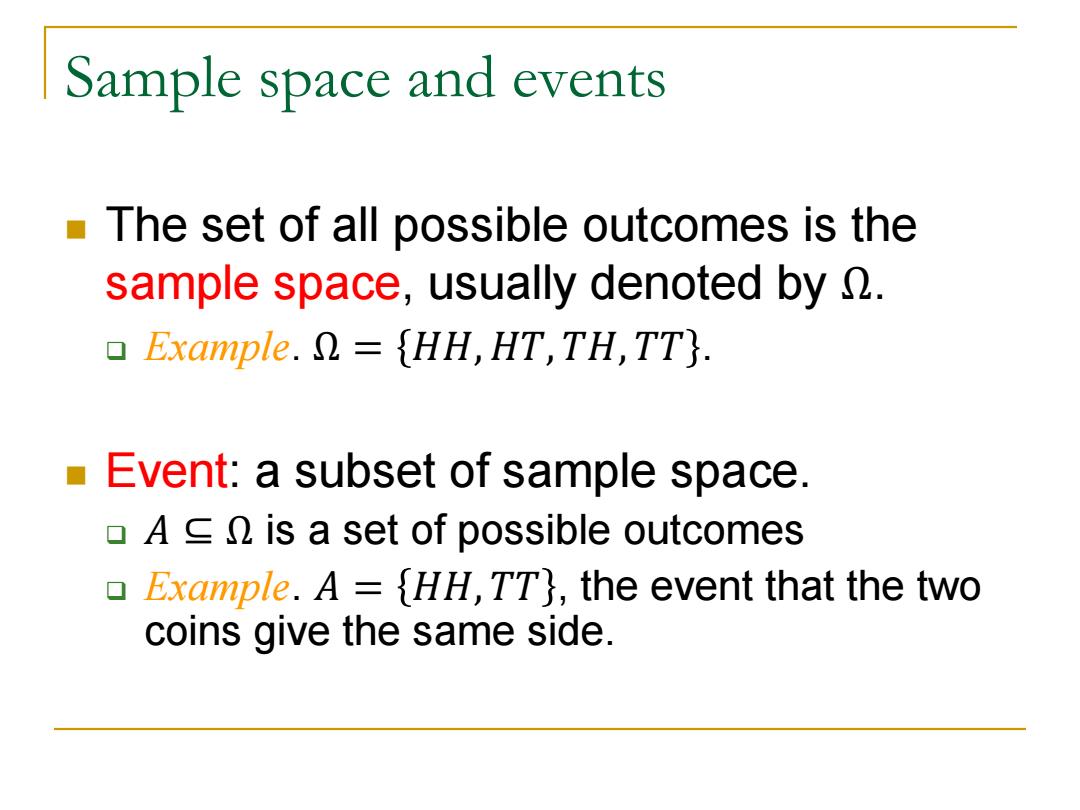
Sample space and events The set of all possible outcomes is the sample space,usually denoted by 0. Example.=HH,HT,TH,TT. Event:a subset of sample space. A n is a set of possible outcomes Example.A =HH,T'T,the event that the two coins give the same side
Sample space and events The set of all possible outcomes is the sample space, usually denoted by Ω. Example. Ω = 𝐻𝐻, 𝐻𝑇, 𝑇𝐻, 𝑇𝑇 . Event: a subset of sample space. 𝐴 ⊆ Ω is a set of possible outcomes Example. 𝐴 = 𝐻𝐻, 𝑇𝑇 , the event that the two coins give the same side
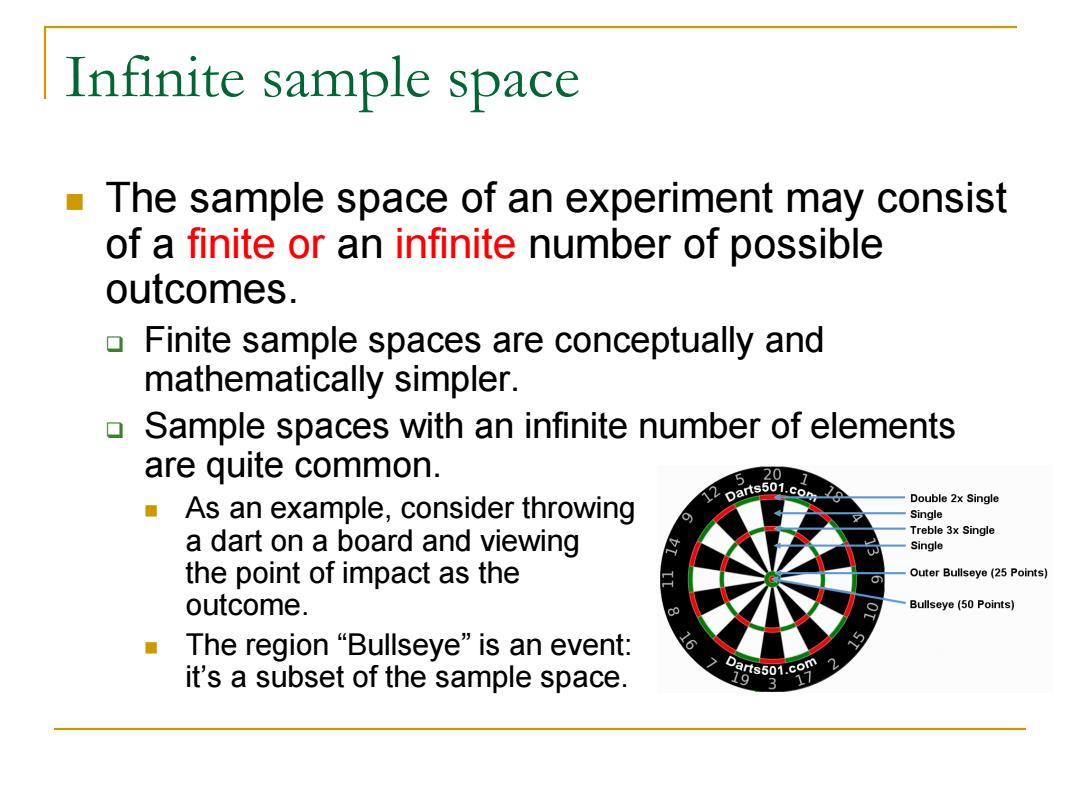
Infinite sample space The sample space of an experiment may consist of a finite or an infinite number of possible outcomes. Finite sample spaces are conceptually and mathematically simpler. Sample spaces with an infinite number of elements are quite common. 20 parts501.com As an example,consider throwing Double 2x Single Single a dart on a board and viewing Treble 3x Single Single the point of impact as the Outer Bullseye (25 Points) outcome. Bullseye(50 Points) The region“Bullseye”is an event: it's a subset of the sample space. 9ts501.co
Infinite sample space The sample space of an experiment may consist of a finite or an infinite number of possible outcomes. Finite sample spaces are conceptually and mathematically simpler. Sample spaces with an infinite number of elements are quite common. As an example, consider throwing a dart on a board and viewing the point of impact as the outcome. The region “Bullseye” is an event: it’s a subset of the sample space